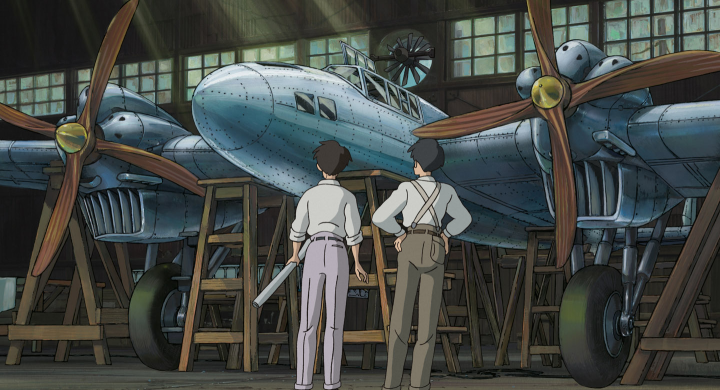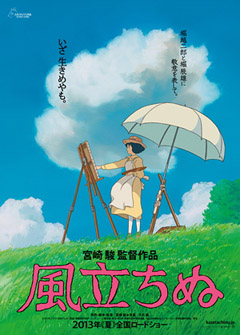
風立ちぬ — The Wind Rises

Miyazaki’s latest is big and messy and disturbing and sad and very beautiful. We took two seven-year-old girls to see it because, well, Miyazaki; a mistake, this is for grown-ups.

It’s biographical and the protagonist is a real person: Jiro Horikoshi, most famous as the designer of the Mitsubishi Zero fighter plane, which dominated the first half of the Pacific-aerial part of WWII.
The movie also has an earthquake, a Great Fire, an Italian count/airplane-designer, a tribute to Thomas Mann, a romance, and a fatal disease. It’s also sl-o-o-ow. (Which is one of the things I’ve always loved about Miyazaki, his willingness to take a scene, even one that’s peripheral to his story, and let it run and run and run. Just about every critic ever has raved about the Ghost Train ride in Spirited Away, in which nothing happens and the story doesn’t progress.)
In fact, the payload is so big and the pace so slow that too many storyline threads are only just barely sketched in: The secret-police investigation, the failure of Caproni’s big plane, Naoko’s three letters, and so on.
I saw the Japanese version with subtitles; I’m wondering if there was something wrong with the media, because some of the animation just wasn’t up to Miyazaki standards; in particular, most of the (many) scenes with planes crossing the sky were stutter-stepping furiously. So maybe I’ll go see it again when the English version comes out, because the dub cast looks impressive.
Another reason to go back would be that the movie’s got many segments of breathtaking beauty.

But yeah, there’s a problem. What we have here is art that’s all about glorifying and romanticizing people who built killing machines that were put to use by a fascist government. And the Zero may have been a great plane but it sure didn’t look like the graceful, angular creations featured in the The Wind Rises.
Miyazaki admits to having a soft spot for the Zero, which I find frankly weird in a guy whose oeuvre oozes humanism. Oh well, lots of masterpieces are messy and flawed. This one hasn’t really dislodged Spirited Away and Totoro from their places next to my heart, but it sure made an impression.
Comment feed for ongoing:
From: Chris E (Mar 19 2014, at 05:53)
I think you are misunderstanding the tone of the film - after all, to show is not to justify.
I think Miyazki is trying to show how closely triumph and success, beauty and horror end up being linked. The plane and the devastation it causes are paralleled by Jiro's career vs his neglecting of his wife.
[link]
From: Ian Rae (Mar 19 2014, at 07:24)
Saw the movie last week. My 20-year-old son (raised on Miyazaki) loved it, but we felt sorry for the families with small kids.
The troubling part about applying art and love to design warplanes is pure Miyazaki. He has never been big on good versus evil, and sees a world of mixed motives and shades of grey. I took his point to be that we all work on things of dubious value more than we would like to admit. To the extent that our society is unjust, unsustainable, and evil, it is we who have built it.
[link]
From: Ben Ramsey (Mar 19 2014, at 08:43)
The English-dubbed edition is out in theaters in the US. I was able to go see it this weekend, and it was amazing. I agree with your observations about the slow-moving scenes and "sketches" of story, but I loved these scenes.
Even as one far removed from the conflict of WWII, I found myself moved by this story of the designer of planes that would eventually be used in war to attack my country. Myazaki's personal dedication to peace is contradictory to the use of the planes, but I think that's what makes the story work: it is about a young man with a passion and love for designing the greatest flying machines, in spite of the fact that these "beautiful" flying machines will cause death and destruction. It's a sad story.
[link]
From: Edd (Mar 19 2014, at 13:17)
The English-language version is already out in Canada two, saw it on the North Shore two weeks ago.
I had many of the same reservations as you, but they significantly faded over the following days. Especially given the tone of the final few minutes.
[link]
From: PeterL (Mar 20 2014, at 23:33)
I am so jealous that you could see it in the original language; in San Francisco it seems to be only available in English.
[link]
From: Larry Dee (Mar 23 2014, at 04:36)
I live in Japan and saw the Japanese version.
Prior to its release we were subjected to a huge amount of publicity about the movie, since Miyazaki is a national treasure here. NHK, as they've done for his last few, followed him around for years as the movie was being made, and I saw that documentary before I saw the movie. Big mistake.
It turned out that Miyazaki cast one of his animators as the voice of the main character. I just could not get that out of my head for the whole movie. I can see how Miyazaki liked the guy's vocal quality, but over the course of such a long movie the lack of acting chops really grates. It drove me crazy.
So I'd like to see the English version if I see it again.
The Zero is a lot like the Hughes H-1 Racer. Both real masterpieces of minimalist functionality for a prop plane. In fact, Hughes claimed that the Zero was a ripoff of the H-1.
[link]
From: PeterL (Apr 06 2014, at 21:37)
I refuse to watch dubbed versions of Miyazaki — the translations are usually so bad and often distort the the original. Are the translators that incompetent, or does Disney think it's an "improvement" on the original? Guess I'll have to wait for the DVD.
[link]